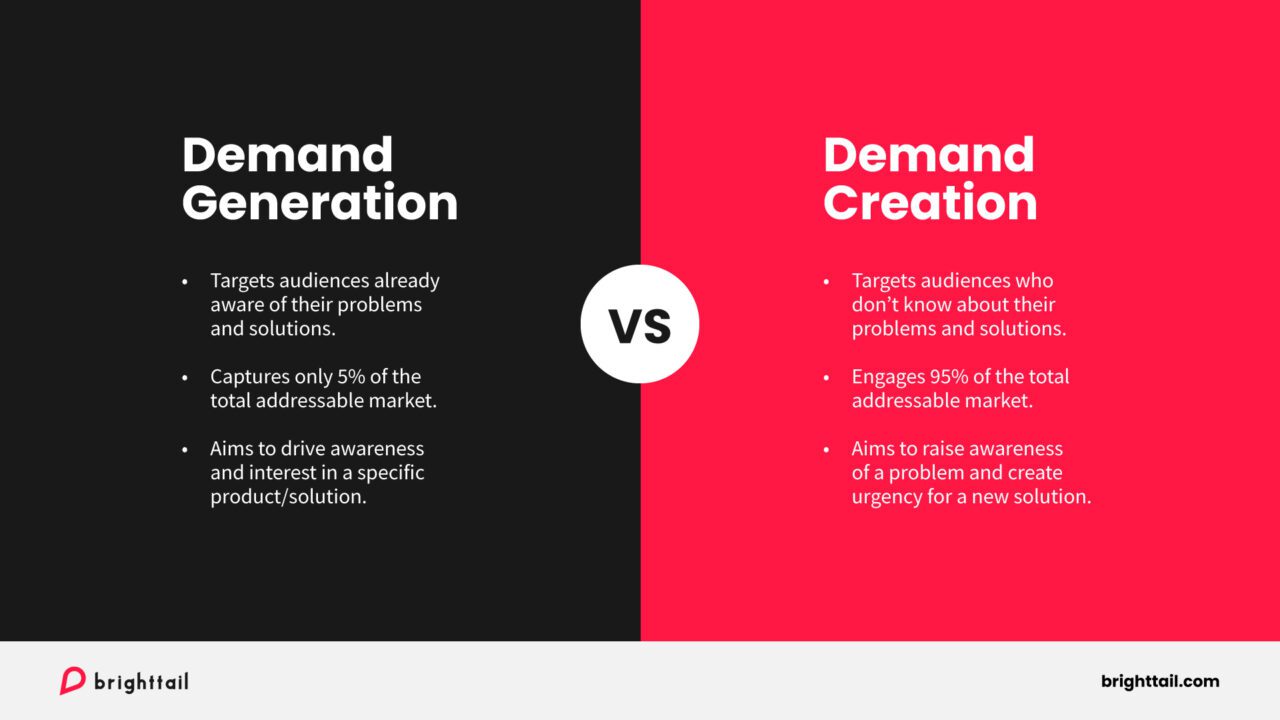Whether you’re a seasoned CMO or just dipping your toes into the world of marketing, understanding the ins and outs of demand creation is crucial for success in today’s hyper-saturated market. However, the concept of demand creation isn’t as widely discussed – and is often confused with another marketing framework – brand building. While marketers often recognize the need to build brand and problem awareness, they don’t always fully distinguish between the two.
So what exactly is demand creation, and why is it so essential? How is it different from demand capture and brand building?
In this blog post, we break down the basics of demand creation and how it’s different from, but doesn’t conflict with, demand capture. We’ll also provide you with a list of resources you can check out if you want to dive deeper into demand creation and try it out for yourself.
What is demand creation?
Firstly, let’s delve into what demand creation is all about. Demand creation falls under the umbrella of demand generation. Its purpose is within its name; this strategy seeks to create new demand where none currently exists. Instead of talking to the same people who are already being bombarded by marketing and advertisements from your competitors, demand creation helps you expand your scope and speak to a new and untapped audience.
Unlike demand capture or lead generation, demand creation targets out-of-market buyers who make up a larger percentage of your total audience. It is not meant to drive leads or capture buyer information. Instead, demand creation seeks to generate awareness of the problem, position your brand as the solution expert, and encourage engagement. Because if your brand is the one responsible for helping your audience define their buying vision, they will turn to you first for a solution.
TLDR; demand creation ignites interest among out-of-market audiences who are unaware of their problem, pulling them into the marketing funnel.

All the resources you need to know more about demand creation
Demand creation is just as critical for your brand as lead generation. In fact, it’s a good idea to run both campaigns if you want a holistic marketing strategy that can deliver short-term wins and build a foundation for the long term.
Don’t just take our word for it; here are some links that cover everything you’ll need to know about demand creation:
1 | The 95:5 rule tells us that the majority of buyers aren’t in the market now.
Written by Professor John Dawes of the Ehrenberg-Bass Institute for Marketing Science, this paper talks about why traditional B2B advertising mainly falls on deaf ears as 95% of buyers aren’t actively looking for a solution. Only 5% are actively looking for a solution.
That’s why Dawes recommends “to grow a brand, you need to advertise to people who aren’t in the market now, so that when they do enter the market, your brand is the one they are familiar with.” This puts you ahead of your competition and increases your buyer’s purchase propensity.
Tip: Here’s another essential reading on the 95:5 rule from LinkedIn’s B2B Institute! This one goes into more detail about the in-market marketing myth and how it applies to today’s marketing environment.
2 | Buyers have become numb from being bombarded by the same tactics.
It’s time for a change. Jon Miller introduces a new B2B playbook mapped to the basic buyer’s journey of awareness, consideration, and decision which focuses on rethinking old lead generation tactics in favor of creating demand. The goal here is to help the right buyers become aware of their problem so they start to seriously think about solutions.
“Success here means dropping traditional B2B demand generation metrics such as cost-per-click and cost-per-lead,” writes Miller. “The goal is moving accounts through the buyer’s journey.”
3 | Demand creation drives pipeline growth.
Demand creation targets new audiences and reaches out to out-of-market audiences, making them realize they have a problem and they’re missing out. In other words, “it takes your big idea – the creative appeal of your brand – and turns it into sales.”
This blog post by MX Group sets out four stages of demand creation: identify your audience, attract them, create easy ways your audience can use to engage with you and manage the demand.
4 | It’s not about demand capture vs demand creation – you need both to succeed.
In this episode of Stacking Growth, Tory Kindlick, Liz Spektor and Myles Madden break down the difference between demand capture and demand creation, and why it’s not a question of either or, but a matter of doing both.
Demand creation expands your target audience, spreads problem-awareness, and keeps your brand top of mind. Demand capture leads them through the funnel, giving them more information about your product and more opportunities to engage, driving them towards making a purchase. Both are essential to a holistic marketing strategy.
5 | In 2023, CMOs are making the shift away from chasing leads to creating demand.
With so much competition for the same pool of prospects, CMOs today have realized that traditional lead generation strategy has reached a breaking point. “A lot of marketing teams were very focused on low-hanging demand capture,” said Katie Hollar, VP of Development at Clutch. “But I think there’s been a shift back to creating problem awareness first.”
In this report, 10 CMOs share their current challenges and how they’ve made the shift towards creating demand, including tips like ungating content and investing in branding.
6 | Demand creation may be a long-term marketing strategy but it’s worth the risk. Here’s why.
Short-term strategies give marketers immediate ROI and quicker results. However, they tend to be unsustainable and put pressure on marketers to spend more resources to chase after that short-lived high. That’s where long-term marketing strategies come in. Long-term planning done well “sets your business up to realize short-term gains in addition to long-run advantages.”
7 | Buystander personas are a new way to find your out-of-market audience.
If you want to reach that 95%, you’ll need to understand who they are, what’s stopping them from actively searching for a solution, and what it would take to convert them into buyers. Just like how buyer personas help you identify your prospective customers, this e-book introduces Buystander personas as a great way to identify your out-of-market audience.
“To successfully create demand for our solution, it’s imperative that B2B marketers get into the streets and see our audience’s world through their eyes,” writes Matthew Lewsadder, author of Buystander Personas. “Buystander personas empower marketing leaders like you with the insights you need to win where others aren’t competing.”
Create demand today
Demand is elusive. That’s why demand creation truly is the key to unlocking new horizons in marketing, especially if you’ve found yourself hitting the ceiling on lead generation. Done well, demand creation can be the bridge that connects your brand to a bigger audience and drives long-term, sustainable growth.
You just need to take that first step.



